Original: Presto Research
Compiled by: Odaily Planet Daily Golem
Key Points:
The popularity of whale alerts stems from the belief that large on-chain transactions often signal an impending token sell-off and serve as sell signals. To evaluate these claims, Presto Research analyzed the price changes of BTC, ETH, and SOL following large deposits to Binance.
According to regression analysis, the R-squared values between large transaction deposits and subsequent price changes are low (ranging from 0.0017 to 0.0537). Narrowing the data to deposits from VCs and MMs (market makers) slightly improved the R-squared values, but their actual utility as trading signals remains limited. The findings strongly suggest that whale deposits to exchanges lack predictive power as reliable trading signals.
On-chain metrics are effective in other areas, such as analyzing blockchain fundamentals, tracking illicit fund flows, or explaining price fluctuations. They will better serve the industry only when investors have more realistic expectations about their capabilities and limitations.

One of the main differences between crypto assets and other assets is the public availability of their transaction records, which are stored on a distributed ledger. The transparency of this blockchain has led to the emergence of various tools that leverage this unique characteristic, all classified as "on-chain data." One such tool is "Whale Alerts," an automated service that notifies users of large on-chain crypto transactions. They are popular because large transactions are often seen as precursors to impending sell-offs, thus regarded by traders as "sell signals."
This report assesses the validity of this widely accepted hypothesis. After briefly outlining the popular whale alert services in the market, we will analyze the relationship between large transaction deposits and the prices of BTC, ETH, and SOL. We will then present the analysis results and provide key conclusions and recommendations.
Overview of Whale Alerts
Whale Alerts refer to services that track and report large crypto transactions. These services emerged as the crypto ecosystem developed, reflecting market participants' high recognition of the transparency features of blockchain.
History
As early Bitcoin adopters, miners, and investors (such as Satoshi Nakamoto, the Winklevoss Twins, F2Pool, and Mt. Gox) accumulated large amounts of Bitcoin, the term "whale" began to gain popularity. Initially, blockchain enthusiasts monitored large transactions through blockchain explorers (like Blockchain.info) and shared this information on forums like Bitcointalk or Reddit. This data was often used to explain significant fluctuations in Bitcoin's price.
During the 2017 bull market, as the number of whale transactions and large trades increased, there was an urgent need for automated monitoring solutions in the market. In 2018, a European development team launched a tool called "Whale Alert," which tracks large crypto transactions across multiple blockchains in real-time and sends alerts via X, Telegram, and web. The tool quickly gained favor among market participants, becoming the preferred service for those seeking actionable trading signals.
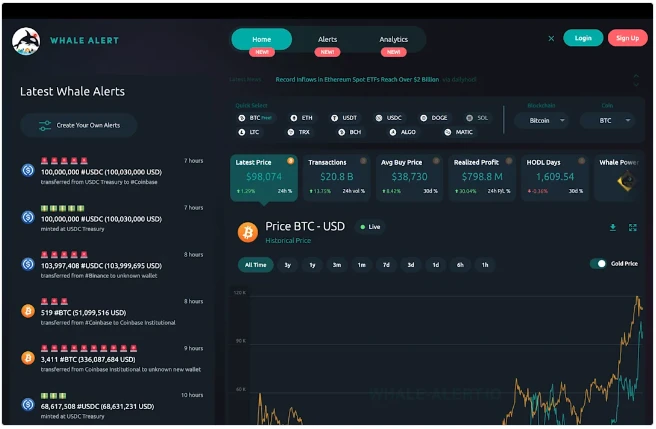
Source: Whale Alert (@whale_alert)
Basic Assumptions
Following the success of Whale Alert, many platforms offering similar services have emerged over the years, as shown in the figure below. Although many new platforms have added more features to provide context for alerts, the original Whale Alert still focuses on simple, real-time notifications and remains the most popular service, as evidenced by its large following on X. A common characteristic of all these services is their reliance on the assumption that large on-chain transactions (especially exchange deposits) foreshadow impending sell-offs.
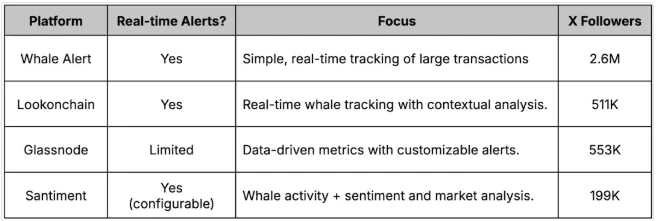
Mainstream whale alert services, sources: Whale Alert, Lookonchain, Glassnode, Santiment, X, Presto Research
Signal Validity Assessment
Supporters of Whale Alert services argue that on-chain asset transfers to exchanges often precede liquidations, making them effective sell signals. To validate this hypothesis, we analyzed the price changes of digital assets following large deposits to exchanges, with the following figure illustrating the key parameters of the analysis. The assumption is that if large transaction deposits can serve as reliable trading signals, a clear relationship should be observable between the deposits and the corresponding asset prices.

Key parameters of the analysis, source: Presto Research
Asset Types, Exchanges, Analysis Period, and Deposit Thresholds
Our analysis focuses on three major crypto assets—BTC, ETH, and SOL—and their USDT prices on Binance from January 1, 2021, to December 27, 2024. This time frame was chosen to align with the operational duration of the wallet addresses currently used by Binance to aggregate deposits.
The deposit thresholds were set based on an analysis of exchange data. Specifically, using Whale Alert's thresholds of $50 million for BTC and ETH and $20 million for SOL as a baseline, we adjusted the deposit thresholds down to $20 million, $20 million, and $8 million, respectively, which corresponds to Binance's 40% share of global spot trading volume.
Entity Types
We also specifically analyzed deposits from known entities and conducted the same analysis on a narrower data sample to check whether deposits from specific types of entities exhibited a stronger relationship with price movements. These entities were identified through Arkham Intelligence and supplemented by our own investigations, as shown in the figure below.
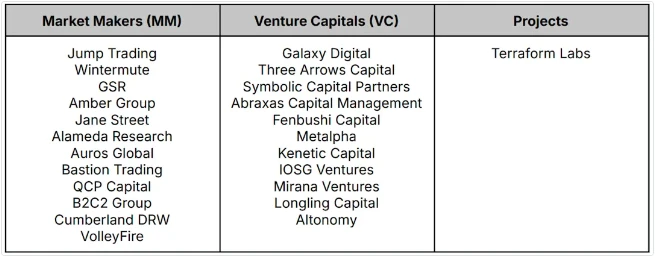
Entities with known addresses, sources: Arkham Intelligence, Presto Research
Measuring Market Impact
To assess the potential sell-off pressure from whale deposits, we made the following assumptions:
- Sell-off pressure will manifest within a specific time frame after confirming on-chain deposits exceeding the threshold. We analyzed two time periods: one hour and six hours.
- The maximum drawdown (MDD) within the specified interval serves as an indicator to measure the price impact of deposits (if any), effectively filtering out noise during that period.
Results
The analysis results are illustrated in the following figures:
- Impact of BTC whale deposits (all):

Source: Binance, Dune Analytics, Presto Research
- Impact of BTC whale deposits (VCs and MMs only):
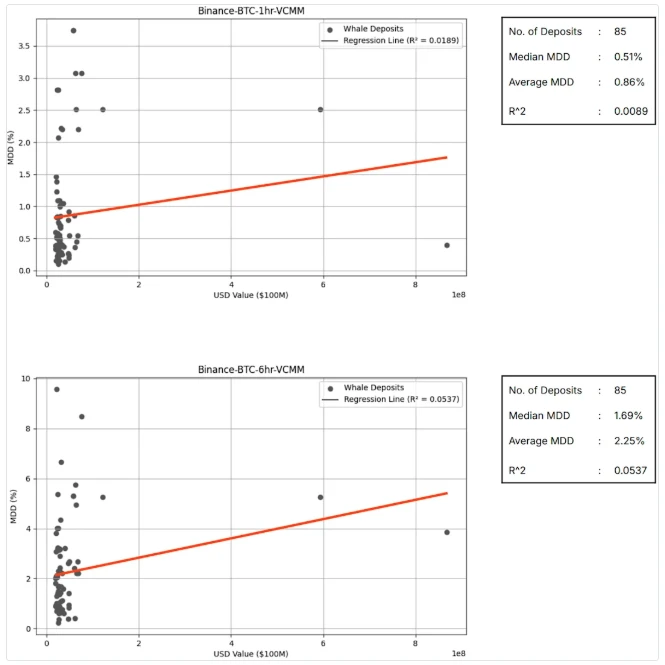
Source: Binance, Dune Analytics, Presto Research
- Impact of ETH whale deposits (all):
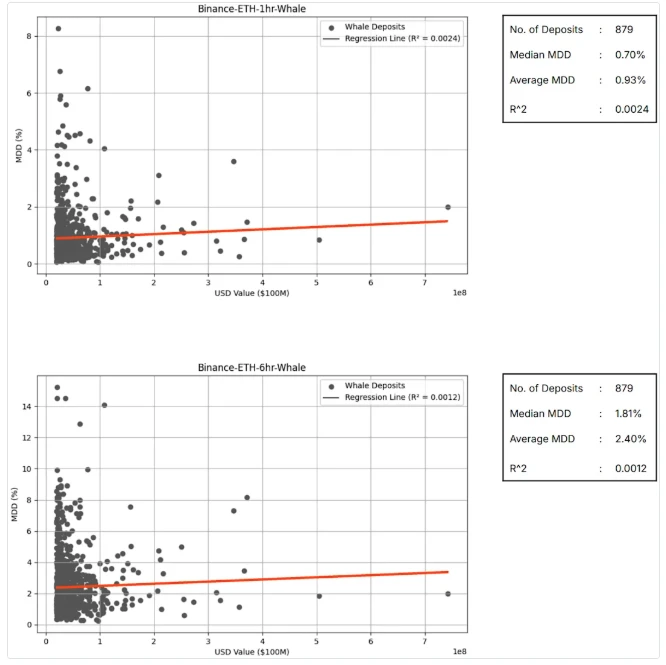
Source: Binance, Dune Analytics, Presto Research
- Impact of ETH whale deposits (VCs and MMs only):
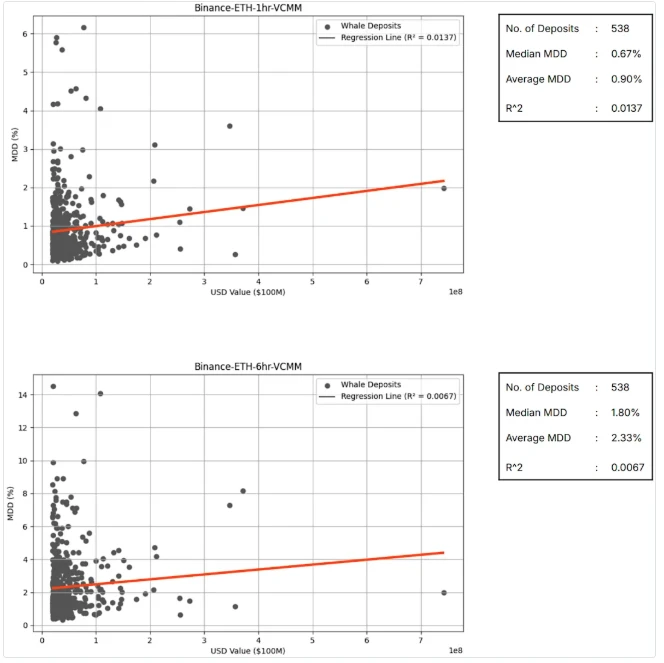
Source: Binance, Dune Analytics, Presto Research
- Impact of SOL whale deposits (all):
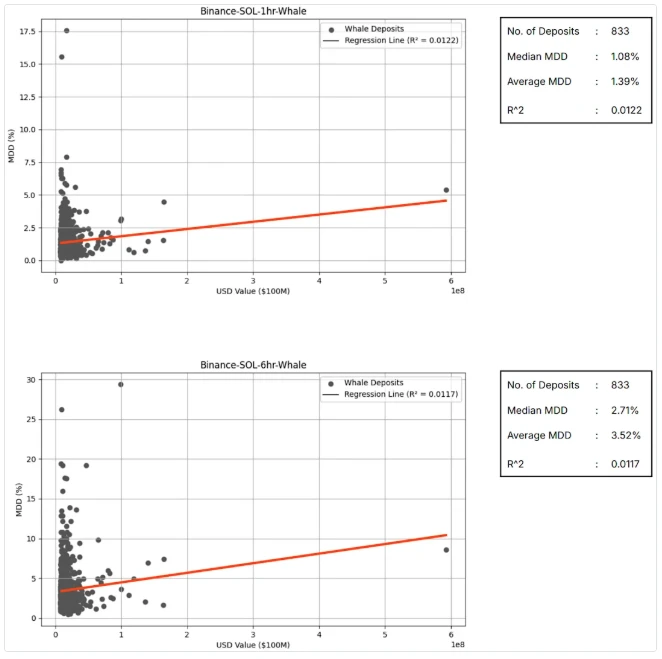
Source: Binance, Dune Analytics, Presto Research
- Impact of SOL whale deposits (VCs and MMs only):

Source: Binance, Dune Analytics, Presto Research
Key Takeaways
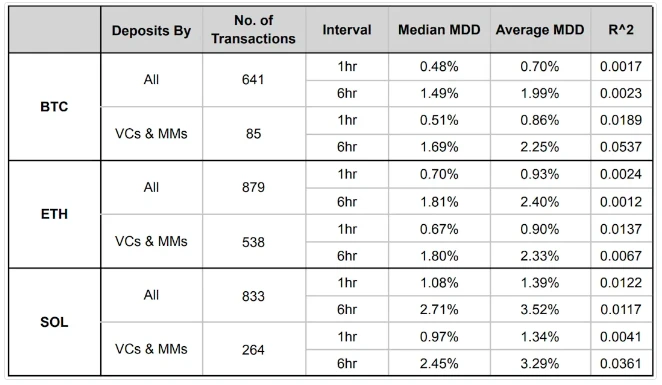
Source: Binance, Dune Analytics, Presto Research
The above figure summarizes the results of the statistics, leading to the following three conclusions:
- The predictive power of large exchange deposits for price declines is weak: The R-squared values for all 12 scenarios indicate extremely weak predictive power, ranging from 0.0017 to 0.0537.
- Deposits from VCs and MMs may be slightly better predictive signals: In this subset of data, the R-squared values improved, but this improvement may merely be a result of reduced sample noise rather than a true stronger correlation. Furthermore, the absolute values remain low, indicating limited actual effectiveness as trading signals.
- Whale deposits in ETH primarily come from VCs and MMs: They account for 61% of ETH whale deposits (i.e., 879 out of 538 transactions), while BTC only accounts for 13% and SOL for 32%. This reflects the characteristics of different assets: ETH has a higher turnover due to its diverse Web3 uses (e.g., gas fees, staking, DeFi collateral, and swap medium), while BTC, as a store of value asset, is more stable.
Conclusion
Admittedly, our analytical approach has certain limitations, and regression analysis has its inherent constraints; relying solely on R-squared values to draw conclusions can sometimes be misleading.
That said, this analysis, combined with context and individual observations, strongly suggests that whale deposits to exchanges lack sufficient predictive power to serve as reliable trading signals. This also provides us with profound insights into the broader use of on-chain metrics.
On-chain metrics are undoubtedly valuable tools, especially for analyzing blockchain fundamentals or tracking illicit fund flows, and they may also be useful for post-hoc explanations of price movements. However, using them to predict short-term price changes is an entirely different matter. Prices are a function of supply and demand, and exchange deposits are just one of many factors influencing the supply side, even if they are genuinely useful. Price discovery is a complex process influenced by fundamentals, market structure, behavioral factors (such as sentiment and expectations), and random noise.
In the highly volatile cryptocurrency market, participants are constantly seeking "foolproof" trading strategies, and there will always be an audience drawn to the "magic" of on-chain metrics. When some "overzealous" data providers rush to exaggerate the promises of their platforms, investors can only benefit from these tools when they have realistic expectations about their capabilities and limitations.

免责声明:本文章仅代表作者个人观点,不代表本平台的立场和观点。本文章仅供信息分享,不构成对任何人的任何投资建议。用户与作者之间的任何争议,与本平台无关。如网页中刊载的文章或图片涉及侵权,请提供相关的权利证明和身份证明发送邮件到support@aicoin.com,本平台相关工作人员将会进行核查。




